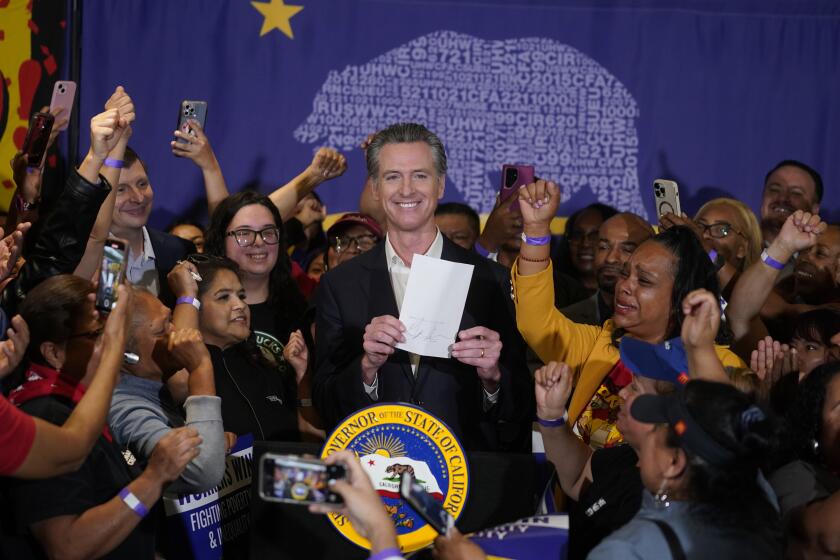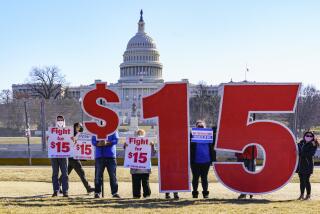Column: The latest info on California’s $20 minimum wage for fast-food workers — higher pay, no job losses and minimal price hikes

Which of California’s economic initiatives drives conservatives batty the most? No question: It’s the state’s $20 minimum wage for fast-food workers, which went into effect April 1.
For months before the wage increase, conservative pundits and economists filled the airwaves and newspaper columns with predictions that it would produce an employment bloodbath at fast-food restaurants.
Some went further, purporting to find actual evidence of huge job losses. The Wall Street Journal claimed to have discovered losses of 10,000 jobs between September 2023 and January 2024, even before the new wage went into effect. The estimate was duly parroted by the conservative Hoover Institution.
What’s good for workers is good for business, and as California’s fast-food industry continues booming every single month our workers are finally getting the pay they deserve.
— Gov. Gavin Newsom on the state’s $20 minimum wage for fast-food workers
Two new analyses of the actual wage and price impacts of the $20-per-hour minimum have appeared this month. They employ slightly different statistics, but their conclusions are the same: There have been no job losses in fast food resulting from the increase. By some measures, employment has increased.
The first analysis to appear came from the Institute for Research on Labor and Employment at UC Berkeley. It found no measurable job losses, significant wage gains (as one might expect from raising the minimum wage to $20 from an average of less than $17), and modest price increases at the cash register averaging about 3.7% — far lower than the fast-food franchise lobby claimed were necessary.
Get the latest from Michael Hiltzik
Commentary on economics and more from a Pulitzer Prize winner.
You may occasionally receive promotional content from the Los Angeles Times.
The second comes from a joint project of the Harvard Kennedy School and UC San Francisco. Not only did that survey find no job losses, but it also debunked claims or conjectures from minimum-wage critics that the increase would show up as reductions in hours or fringe benefits.
Nothing of the kind has surfaced in the months just before or just after the new law, according to the Harvard-UCSF survey’s authors, Daniel Schneider of Harvard and Kristen Harknett of UCSF.
“In response to wage increases,” they wrote, “employers could have looked to cut costs by reducing fringe benefits such as health or dental insurance, paid sick time, or retirement benefits. We find no evidence of reductions.”
These results are important for several reasons. One is that the fast-food minimum wage increase is one of the sharpest ever, and the resulting wage the highest in the country (with a few minor exceptions).
The Trump administration ended eligibility for overtime pay protection for 8.2 million workers. That makes his proposal to make OT pay tax-free hollow indeed
It’s also one of the most tightly targeted, applying to California stores of fast-food chains with more than 60 nationwide locations. The sector employs about 750,000 workers in the state, 90% of whom were paid less than $20 an hour — on average, slightly less than $17 — before the new wage went into effect.
“This is a big deal because of how many workers are getting raises,” UC’s veteran labor expert Michael Reich, the lead author of the Berkeley study, told me. The estimated average 18% raise for affected workers means that some will be able to afford a better apartment or a used car. Employers get benefits too: “The minimum wage kills a lot of vacancies and improves the supply of labor coming to those restaurants.” That means less worker turnover, which is a bothersome expense.
The fast-food raise has been presented as a signature achievement by California’s Democratic governor, Gavin Newsom, who depicts it as emblematic of the state’s progressive labor policies. “What’s good for workers is good for business, and as California’s fast-food industry continues booming every single month our workers are finally getting the pay they deserve,” Newsom said in August.

California has been a leader in raising minimum wages. The overall state minimum wage this year is $16 an hour and is scheduled to rise to $16.50 on Jan. 1; that’s the highest state-level minimum and the highest except for the District of Columbia, where it’s $17.50. (Certain localities in some states have higher minimums.) The California minimum wage for certain healthcare workers will rise to between $18 and $23 on Wednesday.
The issue is also timely, for California voters will be asked on election day to vote on a minimum wage increase for employees at all but the smallest businesses to $17 immediately and $18 on Jan. 1.
All that has made the fast-food minimum a favorite target for employers, their lobbyists and some right-of-center economic commentators.
Fast-food lobbyists say the higher California minimum wage law led to a loss of nearly 10,000 jobs. The claim is baseless.
The minimum wage issue occupies a peculiar place in economic analysis. Many economists and commentators judge it by intuition — if you raise the price of something, such as the price of fast-food labor, conventional economics say you’ll get less of it. Hence, higher minimum wage, fewer jobs.
But it’s also among the most heavily studied of all economic phenomena, with the overwhelming majority of studies finding little or no employment effect from a higher minimum. But none examined the effects of a minimum higher than $15.
That left the door open for critics of the California minimum to claim that this higher minimum was destined to wreak havoc on fast-food employment. Some jumped the gun by finding job losses even before the law went into effect — ostensibly because employers were cutting jobs in anticipation of higher costs.
As I reported in June, the California Business and Industrial Alliance placed a full-page ad in USA Today, citing the Wall Street Journal’s figure of 10,000 fast-food jobs lost during the fall and early winter and describing 12 restaurants or chains as “victims of Newsom’s minimum wage.”
This was “baloney, sliced thick,” I wrote. Some of the chains listed were victims of other economic factors, such as competition, or financial manhandling by their private equity owners.
The figure of 10,000 job losses proved to be a statistical error: The Wall Street Journal used non-seasonally adjusted job figures, so it missed the fact that fast-food employment always falls in the September-January period, so the looming minimum wage played no role.
That was something of a curveball for UCLA economics professor Lee Ohanian, who had cited the Journal’s figure in two columns published by the Hoover Institution, where he is a senior fellow, writing that the pace and timing of the employment decline made it “tempting to conclude that many of those lost fast-food jobs resulted from the higher labor costs employers would need to pay” when the new law kicked in.
Ohanian told me in June that he hadn’t realized that the figures weren’t seasonally adjusted, and that he would query the Journal about the issue in anticipation of writing about it again. He told me more recently that he did write to the Journal but didn’t receive a reply, and that he hasn’t revisited the issue thus far.
So what do we know now about the $20 fast-food minimum?
Government labor statistics haven’t shown an employment decrease in the fast-food category leading up to the April 1 date or in most of the months since then. The Berkeley researchers, led by Reich, found that fast-food employment rose almost steadily this year from January through August, when it exceeded 750,000 for the first time.
According to the Bureau of Labor Statistics, employment in the sector during that period has run ahead of last year’s monthly figures in every month except June. From April 2023 through August this year, the BLS says, California fast-food employment rose by about 3,200 jobs on a seasonally adjusted basis.
Evidence shows that a 32-hour, four-day workweek with no reduction in pay is good for workers and employers. Why isn’t it a rule in the U.S.?
Reich’s team questioned reports of sizable price increases by restaurants aiming to pass their labor cost increases onto customers. The Wall Street Journal, for example, quoted one restaurant owner saying he had raised menu prices by 10%, and a McDonald’s franchisee fretting about losing his customer base if he had to raise the price of a Happy Meal to $20. This was nothing but a flight of fancy: The price of a Happy Meal in California ranges from $4 to $8 today, depending on its content and size.
Based on their examination of menus from nearly 1,600 California restaurants, the Berkeley researchers calculated the average price increase to be about 3.7% — “or about 15 cents on a $4 hamburger.” That was less than the 4.8% average increase imposed on fast-food customers from April 2023 to April 2024. Their math suggests that fast-food restaurants passed about 62% of their labor cost increase in April to customers; the rest was taken out of profits.
None of this is likely to be the last word on the minimum wage issue. Future increases for fast-food workers will be in the hands of an advisory wage council and subject to legislative oversight. It’s still early in the post-$20 era; wage and price effects may take many more months, even a year, to emerge, though over time the hourly minimums for other employment sectors may move higher, making the fast-food wage less of an outlier.
Employment figures, moreover, can be hard to validate. Several different statistical models are in use by states and the federal government. UCLA’s Ohanian reminded me that the quarterly census of employment and wages of the Bureau of Labor Statistics, which covers about 95% of businesses, is current only through the end of March. The next release, covering the second quarter of 2024, won’t be published until December; it’s calibrated with the bureau’s other estimates only once a year.
Don’t expect anything published then to quash the debate over California’s fast-food labor policy. The evil of the minimum wage is a favorite chew toy in conservative politics.
But the bottom line is that workers in the California fast-food industry are better off today than they were six months ago. Who has a problem with that?
More to Read
Get the latest from Michael Hiltzik
Commentary on economics and more from a Pulitzer Prize winner.
You may occasionally receive promotional content from the Los Angeles Times.














